Follow these strategies to help your business survive a disaster.
Let’s talk about the weather, bad weather. Last year, the U.S. had a record 14 weather and climate disasters that each caused at least $1 billion in damages. Now, let’s talk business, closed businesses. More than 43% of businesses won’t reopen their doors after a disaster, according to Scott Owens, managing director of BluTinuity LLC, a disaster planning and management consulting company. And, for those that open, 29% will fail within two years, he says.
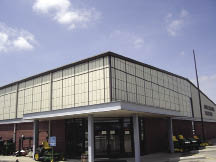
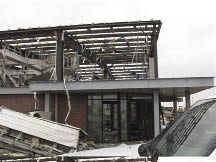
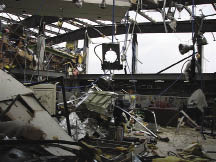
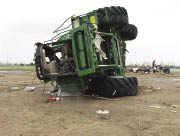
BTI’s Greensburg, Kan., dealership before (top) and after (middle) an EF-5 tornado destroyed it and pretty much all of the town in May 2007. The powerful storm tossed around huge farm equipment like a John Deere combine as if they were toys (bottom). Anything that shuts down your business can prove to be disasterous and underlines the need to have a thorough recovery plan in place.
“If you’ve never had a disaster before, you don’t have a sense of the impact. You think it can’t be that bad,” says Owens. He says businesses often fail because they haven’t made disaster recovery planning a priority.
“Disaster planning is like insurance. You don’t see the value until you need it,” Owens says.
Some disasters, like tornadoes, hurricanes and snowstorms, make the headlines. However, anything that shuts down your dealership is a disaster to you.
“Seventy percent of my recoveries are due to things that just happened to one business,” says Bob Boyd, president and chief executive officer of Agility Recovery. Agility Recovery is a disaster planning and recovery company that works with the Small Business Assn. and agencies on disaster preparedness. They helped develop the website, preparemybusiness.org.
Don’t become another failed business statistic. Develop a disaster recovery plan to increase your dealership’s chances of surviving a disaster, large or small.
Experts say disaster plans should answer these questions:
1. What is most important to my dealership?
2. What are my risks?
3. What kind of data backup do I have?
4. How will I communicate with my employees, customers and others?
5. How will I conduct business while we recover?
6. Does my plan work?
Losing Critical Business Functions
“Organizations are faced with the scary proposition of ‘Where do I start?’ It’s almost a paralyzing thought. It doesn’t have to be that difficult,” Owens says, regarding developing a disaster recovery plan.
Boyd cautions businesses against developing plans that are so complicated they never get finalized.
“Any single thing you do today is better than what you didn’t have yesterday,” Boyd says.
The first step in disaster planning is to know the critical pieces of your business. Think through the effects of not having access to your team, computers, telecommunications, records, equipment, partners and vendors, supply chain, etc. That helps identify exposure to risks and lays out the key components of your plan.
Think through your geographic area, too, such as whether you’re in a flood plain or in an area prone to hurricanes. However, Owens says many of these weather risks can be grouped together because they result in the same effects to your business.

“More than 43% of businesses won’t reopen their doors after a disaster. For those that open, 29% will fail within two years...”
— Scott Owens, BluTinuity LLC
Now, think about “recovery time objective,” a disaster planning term for how quickly you need to recover.
“If I have a disaster now, how much time before my business starts to be affected in a negative way or is seriously in trouble. Based on the process or asset, it could be two hours or two days,” says Owens. He says to think in real terms, like losing sales for a month.
Boyd says that sometimes business owners overlook the importance of a vendor or partner.
“You have to look at key delivery partners. What would happen if that person is not available today? Do you have an alternative?” says Boyd. “A lot of companies have disasters outside of their control that cripple them.”
Save Your Data
Having access to data after a disaster means having access to customers. Owens says securing data used to be more difficult when the storage medium was tapes and disks. Today, dealerships have access to Internet-based solutions, many at a reasonable price.
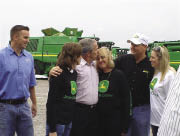
Kelly Estes, president of BTI Corp. (second from right), and his family met with former President George Bush after the tornado.
Regardless of whether you back up your own data or rely on a service, Owens says you should back up data daily, and those back-ups should reside off site. Some say the backup should be stored at least 25 miles from your site, based on the electromagnetic pulse of a nuclear detonation, Owens says. For most businesses, he says that 10 miles is probably sufficient. Take into account certain factors, such as weather, when choosing that location. For instance, in the Midwest, tornadoes are a danger. Tornadoes generally travel from west to east, so make the separation from north to south.
Owens advises this formula when choosing a backup solution: “Think about the dollar amount of that loss. Now, you have a dollar figure that you can look at as an investment.”
People First
The very first step you should take after a disaster is to make sure everyone is safe.
“Any business can run without data. You can’t run your business without your people,” says Boyd. “It’s likely that the same event that happens to your business happens to your employees, too. You need to have the social awareness that everybody is under an unusual amount of stress.”

“Seventy percent of my recoveries are due to things that happened to just one business...”
— Bob Boyd, Agility Recovery
Besides your employees, think about other stakeholders, such as your manufacturer, fellow owners, customers, community and media. Develop a plan for reaching them in various ways. If your email is down, consider turning to social media like Facebook to communicate.
“We’re so tied to our iPhones, our Blackberries and email. Maybe those might not work because Internet or phone system is down,” says Boyd.
Owens says that one of his clients has emergency walkie-talkies. An old-fashioned phone tree can work if phone lines are up.
Think ahead to what you might say. The message you might give to your employees is not the same message you would give to the media, for instance, says Owens.
Sidebar:
Lessons Learned from
The Greensburg Tornado
“When you’re in distress, you don’t want to put yourself at risk of saying something you shouldn’t,” says Owens.
Resuming Business
Continue developing your plan by thinking about how to bring your critical business functions back up. Again, start with your people. Make sure all your processes are fully documented.
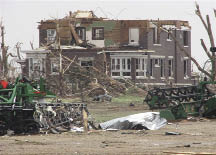
In the aftermath of the Greensburg tornado in 2007, solid brick buildings were totally destroyed and bits and pieces of farm equipment from the BTI dealership were strewn for blocks throughout the town.
“It’s not an attempt to clone a person and put them in a binder. There are some intangibles with people that you are not going to replicate,” Owens says.
Prepare by cross training people. Make sure to have a succession plan for your leaders, to guide who makes the decisions if the owner is unable to.
Think about your physical assets, such as tools, buildings and equipment. Keep a list of tools and equipment and know how you might replace them. Plan for alternate sites and generators for power.
“That alternate site doesn’t have to be an exact replica. Do you have property where you could quickly build a facility? Maybe you have a neighbor with a barn you could rent. You could even approach another dealer with a reciprocal agreement,” says Owens.
Understand your manufacturer’s guidelines regarding damaged equipment and replacing inventory and parts.
Don’t forget the details, says Boyd. For instance, do you have alternate parking. Is it OK for employees to bring their kids in to work temporarily?
“You don’t have to spend one penny, but just think about it,” says Boyd.
Dealer Takeaways
• Many businesses that face a disaster won’t reopen their doors. For those that do, a good share will fail within two years.
• Develop a disaster recovery plan to increase your dealership’s chances of surviving a disaster.
• Make sure your disaster recovery plan identifies risks; helps you recover critical business functions; establishes a data backup policy; outlines a communica- tion strategy for employees and other stakeholders; and has been tested.
• Make sure you have adequate insurance coverage to recover from a devastating loss.
Insurance is a critical component of resuming business. Experts say to regularly check in with your insurance agent to ensure your coverage reflects your business today and that your coverage and policy limits are sufficient to cover major losses. Be sure you understand how much business income coverage you have and how long that coverage lasts. Also, be sure to understand the claims process, including documentation required to prove the loss.
Testing for Failure
Assign a team member to take responsibility for the plan. Make sure everyone has a copy and has participated in testing. Act out the plan in various scenarios. Owens says that he often employs actors to add in the emotional distress of a disaster.
“A document is great, but a lot of times what you see in a real disaster you can’t account for on paper — how people will respond,” says Owens. During many testing scenarios, he sees employees who don’t even remember to look at the plan.
What you learn from the test can strengthen your plan even more, says Owens. For instance, you may realize that someone’s phone number has changed or that you stopped carrying certain inventory.
“At the end of the day, it all becomes one effort. You’ve must have a strategy, a playbook for who is involved and the partners you can turn to for help,” says Boyd.





